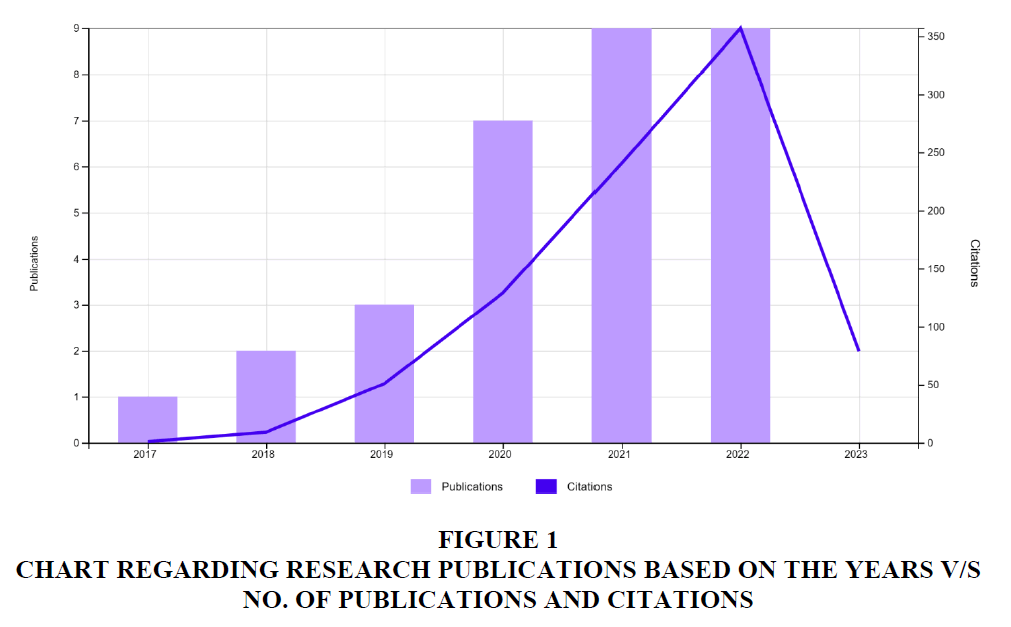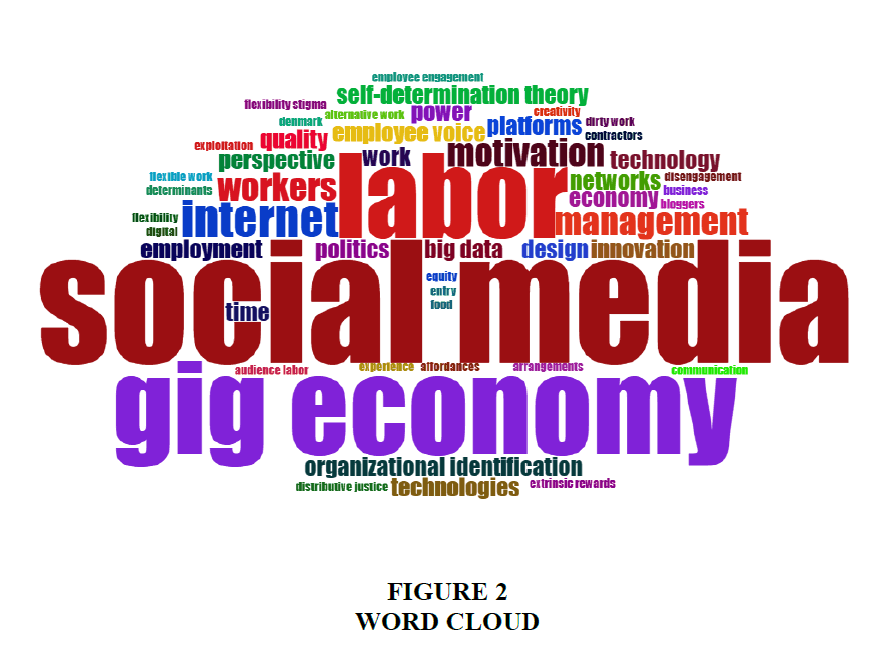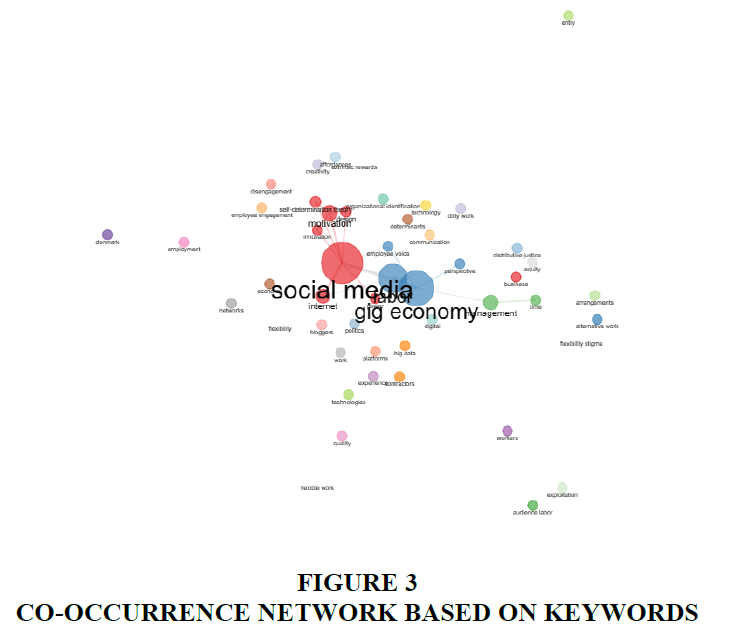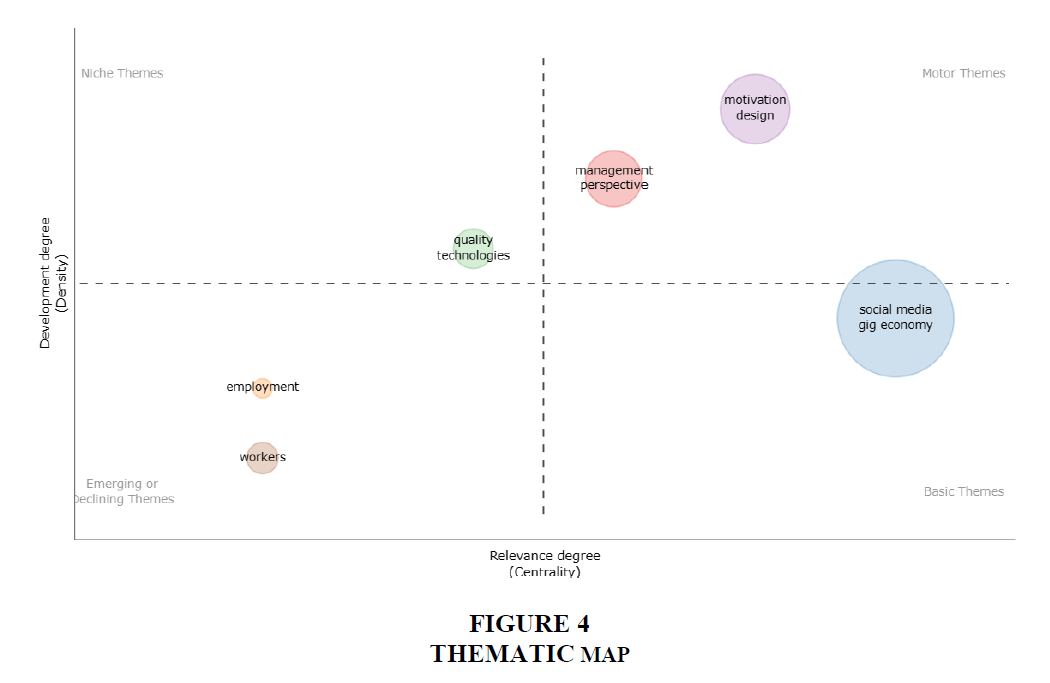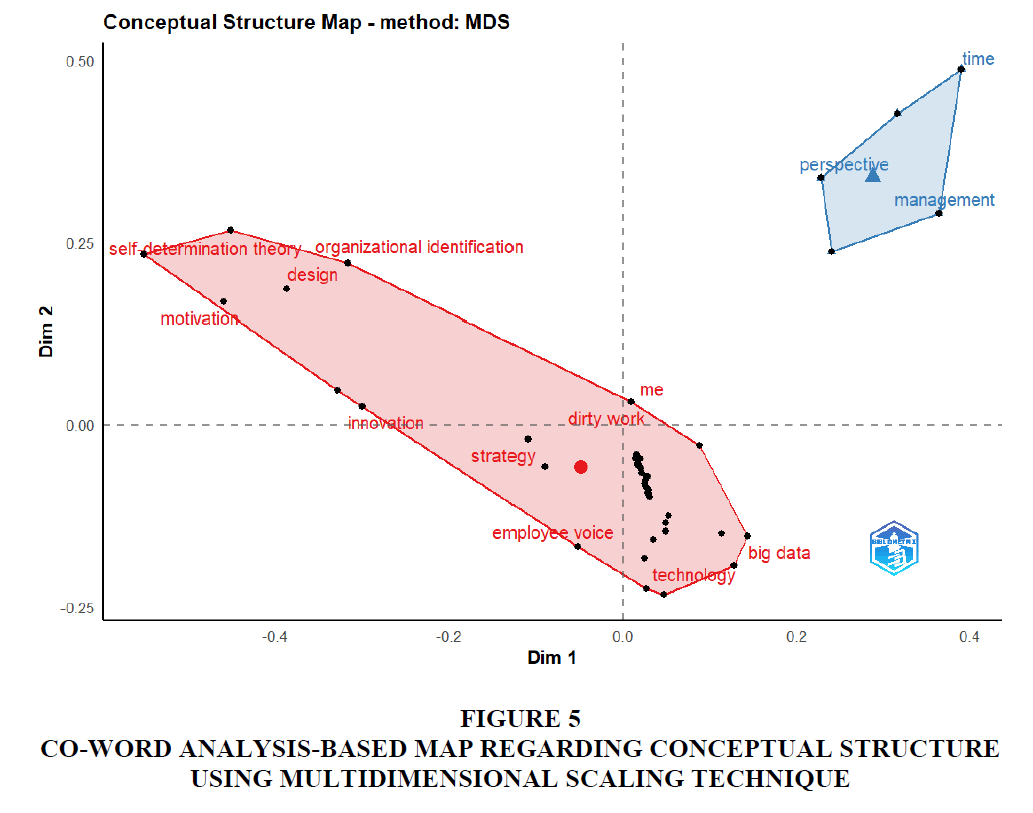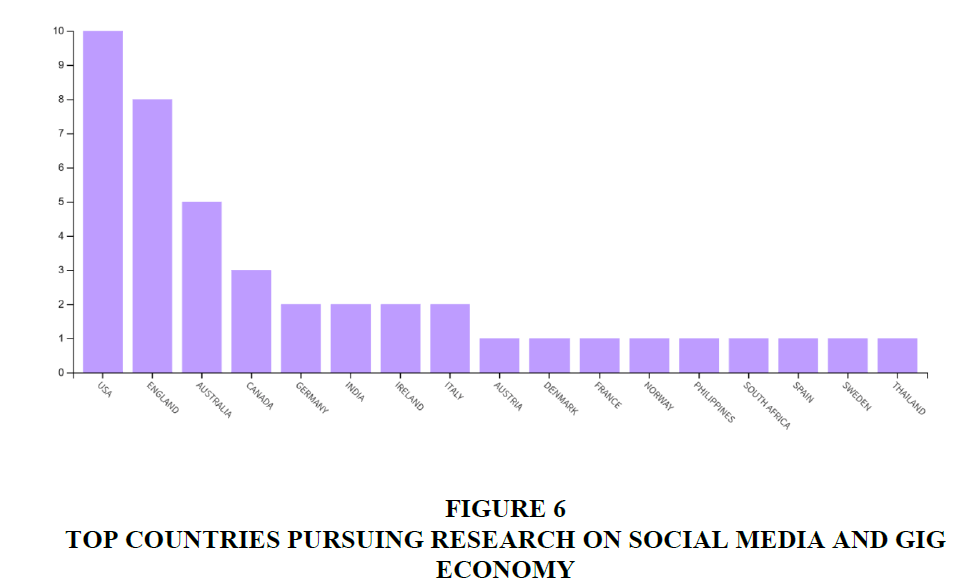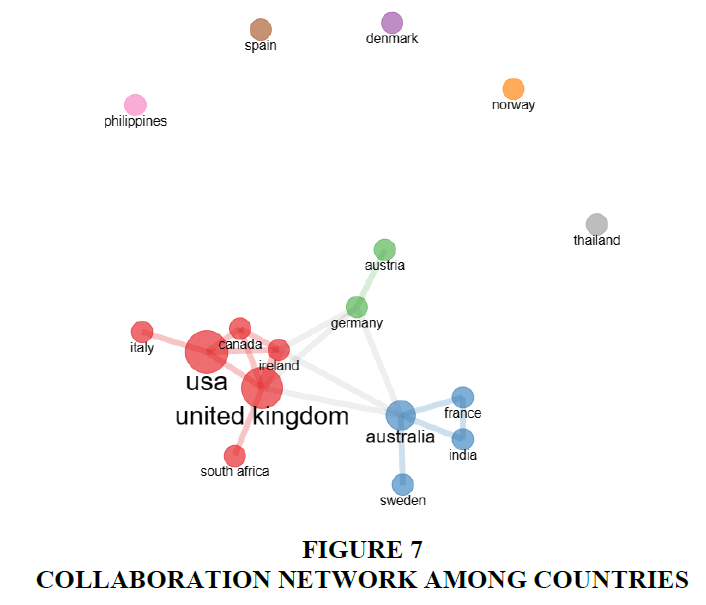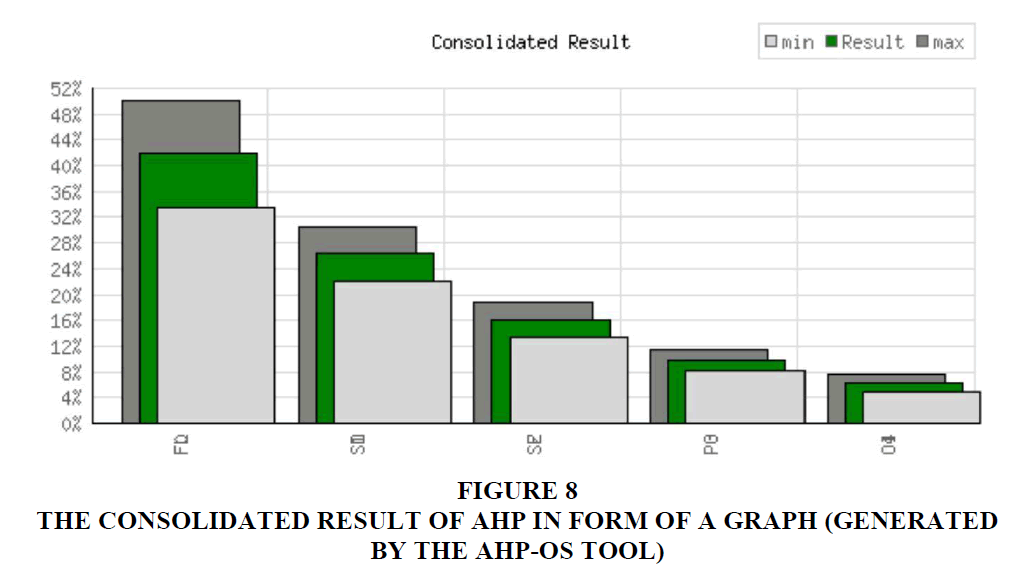Research Article: 2024 Vol: 28 Issue: 6
A Study on Social Media and Gig Economy in Higher Education Institutions during the COVID-19 Pandemic
Nimisha Singh, Indian Institute of Information Technology – Allahabad, Prayagraj
Sarthak Sengupta, IIHMR University, Jaipur
Anurika Vaish, Indian Institute of Information Technology – Allahabad, Prayagraj
Citation Information: Singh, N., Sengupta, S., & Vaish, A. (2024). A study on social media and gig economy in higher education institutions during the covid-19 pandemic. Academy of Marketing Studies Journal, 28(6), 1-15.
Abstract
The research study attempted to explore social media usage among gig workers in higher education institutions during the COVID-19 pandemic. The methodology of the study was based on primary and secondary data. The statistical tools and analytical techniques implemented in the study were bibliometric analysis, country-wise analyses, thematic mapping, statistical surveys, and Analytic Hierarchy Process (AHP). Primary data was collected through self-administered interviews and questionnaires for understanding the working conditions of gig workers in higher education institutions. Secondary data was collected with the help of a literature review and leading research databases across the world. This research study will pave the way for the development of gig workers in higher education to use the full potential of social media to achieve their goals by suggesting various strategic measures. This study found that usage of social media helps them to boost their flexibility, self-determination, and self.
Keywords
COVID-19 Pandemic, Gig Worker, Gig Economy, Higher Education, Social Media.
Introduction
Nowadays gig economy has emerged to be an important theme in modern practices of employment. The major entity of a gig economy are gig workers who are short-term or contractual employees, and freelancers. Giggers or gig workers are employees who have high autonomy, levels of flexibility, variety in tasks, and also complexity in their work. Jobs in this arrangement, i.e., through demand reduce the operating and hiring cost of employers and make entry of employees more transitory in providing them more flexibility. But gig workers are facing various issues in working conditions at higher education institutions. The consequences are being felt in their health also.
Social media is a platform where people interact to provide their viewpoints, ideas, interest, and other forms of creation and sharing of information. This helps in the dissemination of opinions, news, and essential information required for decision-making. It has been observed that social media usage is increasing drastically in higher education. Therefore, social media can help in understanding the working conditions of gig workers while maintaining social distancing norms, healthcare and travel restrictions during the Coronavirus crisis. Moreover, social media has become instrumental in the e-learning environment. So it can be observed that technological development is playing a major role in shaping the future of higher education.
The COVID-19 pandemic has given great rise to work from the home environment as social distancing norms became mandatory in public places. Blended e-learning models are on a rise during the Coronavirus crisis. The health of gig workers have been drastically affected during such trying times. The gig economy is considered to be a non-traditional economic sector. Gig workers were already present in the job market but this pandemic has opened more avenues for them by means of social media (digital platform) that helped in connecting these masses. With the changing times, even the skills set workforce like faculties no more want to stick to their permanent or temporary positions remaining in teaching and research but rather are switching to profiles like an influencer, freelancer, giving motivational talks that not only lift their experience and financial benefits but also give them self-actualization as they want to explore many more benefits of their skill set than sticking to one particular job. We see in private sectors faculties swap as per their perks and benefits but even in government sector faculties look for partial swap to satiate their other skill sets than only teaching. This observation of faculty’s need has led to pursue this research work and therefore the subject on which the work has been carried out is adjunct faculty who have been considered giggers. Just like sharing economy, in case of gig economy also the workers prefer temporary employment.
A lot of research studies worked on social media in higher education with a special emphasis on the COVID-19 pandemic. Many teachers around the globe had to teach online to maintain social distancing norms and travel restrictions during the lockdown. The unexpected pandemic restricted various teaching practices and feedback evaluation challenges for the teaching fraternity. A study found that students were provided written corrective feedback by the teachers online during the Coronavirus crisis. Social media or social networking platforms like YouTube, Facebook, etc., and other emergent instructional technologies are instrumental for teaching purposes. College students should be protected for overall well-being while studying online during such trying times of the COVID-19 pandemic. The Coronavirus had an impact on higher education and this issue should be explored meticulously because educational improvement can help in better outcomes and welfare.
A lot of opportunities boomed for freelancers making all healthy people available for the needy ones. We will study in this paper whether the use of social media has increased opportunities for giggers or not. Also, the giggers like adjunct faculty get their honest feedback because of acceptance through social media usage. Giggers are increasing in number and this paper will focus on how social media is helping them penetrate the market and creating new industries having giggers in various fields. The upcoming sections discuss the literature review, methodology, analysis, and findings along with the conclusion.
Review of Literature
The study also focussed on how social media is helping gig workers penetrate the market and create new industrial avenues for them. Relevant reviews of the literature across the world were collected on social media, the gig economy, gig workers, and higher education. The review of the literature was done from leading sources of relevant research articles. The labour market for faculties has been bifurcated or divided in higher education by the nature of the appointment given to them. The major categorization has been done on the basis of full-time working, part-time working, non-tenure full-time, and non-tenure part-time (guest faculty).
In (Liu et al., 2021) the research study encompasses the impact of social media and takes its feedback from those who are currently pursuing or are aspirants to teach but not as regular faculty. Usage of social media and MOOCs has increased drastically during the COVID-19 pandemic to accelerate the online pedagogical system in higher education institutions.
In (Kaliyar et al., 2021) social media can be very instrumental for collaborative purposes but fake news should be avoided.
In (Magda et al., 2015) Hardly any study or findings are there conveying the perks and issues of faculty members who prefer teaching or are currently working as gigger for taking classes.
In (Finch & Burrel 2012) there has been a shortage of faculties due to retirement or a booming number of institutes. The need for competent faculties to teach has increased. In today's era of high technologies, the traditional way of recruiting faculty will also give a pinch of budgetary constraints. Now faculties have new social media platforms like Linkedin, Facebook, Instagram, etc., to advertise for themselves and work in different institutes on a temporary basis depending on their choice.
In (Darwish, 2019) open educational resources are instrumental in gig businesses.
In (Meisner & Ledbetter, 2022) social media can be an effective tool for self-branding for such workers but they need to follow the norms and protocols of the gig economy.
In (Varadarajan et al., 2023) but nowadays reputational insecurity is a major problem among gig workers may be due to the widespread dissemination of information through social networking platforms. Brand impressions with the help of social media platforms is also gaining huge importance nowadays.
(Meloncon & England., 2016) It's not a new trend that is happening because of the pandemic but it started almost more than a decade ago. Despite their wide existence, we have very minimal data on these contingent positions. In countries like the US, they have departments like Integrated Post-secondary Educational Data System (IPEDS) and National Study of Postsecondary Faculty (NSOPF) which provide basic demographic data. But later due to lack of funding these institutes also ceased and therefore not much information has been gathered. While in our country these studies have not been much explored. The research and findings state that contingent faculty are more enduring and satisfied with this non-tenure status contributing to substantial teachings. The national rise in non-tenure faculty has raised attention towards the changing social and political requirements of this profession.
In (June, 2012) we should realize this “Faculty working conditions are student learning conditions, but we generally do not get that connection”.
In (Gaskell, 2017) Massive Open Online Courses (MOOCS) are the new normal trend happening all over the world. The aim is to understand through an interpretative angle how these courses are taken by contingent faculty and how it acts as an instrument to meet educational ends.
In (Means, 2018) this is becoming the Era of “Digital learning platform”. Now employers are matching the skill set and workers resulting in every gig becoming an “edublock”. Through this, every individual can access learning opportunities and giggers can provide demanded skills. With this set, anyone can teach and anyone can learn at any point in time. It also proposes to digitize education policy and governance so that non-tenure/ temporary/ gig faculty have social protection along with economic flexibility.
In (Fiers, 2023) nowadays, the virtual labor market has plenty of short-term or part time opportunities for gig working.
In (Latack & Dozier, 1986) career transition as a gig worker is the latest transformation taking place. Career transition is defined “…as the period during which an individual is either changing roles (taking on a different objective role) or changing orientation to a role already held (altering subjective state)”.
In (Hackman & Oldham, 1980) the entire motivation behind faculty to switch from regular full-time tenure to non-tenure/guest faculty/ freelancer (gig worker) is self-determination theory and Job design research giving them a digital platform through IT artefacts that impact their motivation.
In (Marson & Croteau, 2019) this gives them self-employment and self-management enabled by Information Technology. Hence social media has contributed to a great extent to giving a platform to giggers to achieve these goals.
In (Wood et al., 2019) research has been done in Southeast Asian and Sub-Saharan African countries where social media plays a crucial role in the online freelancing labor process. Through internet-based social media, they extend support to each other and also share information. This paper basically focuses on that the gig economy doesn't work only in isolation for self-satisfaction but also has a collective impact through the formation of “freelancer unionism” and “freelancer identity”
In (Johinke & Lauro 2020) the gig economy is a market that gives an opportunity to all sorts of skill sets and gives space to work out of the conventional frame. Social Media has given an easy platform to access this market. The employment market has become more fluid with students who want to work casually or on short-term contracts in the gig economy. Mobility and flexibility are the mottoes.
In (Nelson et al., 2020) higher education institutes initially enrolled permanent full-time employees. Job satisfaction is an important factor for both employees and employers. Nowadays employees don't seek their content only in job security but job satisfaction comes from decreased emotional exhaustion, lower stress, higher health-related quality of life, and increased motivation for further training. Studies have shown that interaction with faculty and teaching efficiency impact the satisfaction of students. Gig Economy has entered both research and teaching. On the research side, researchers have started working as freelancers and taking up projects for statistical review and literature searches while teaching is being done as contingent faculty.
In (Mcfeely & Pendell, 2018) independent workers report “high levels of work-life balance, flexibility, autonomy, meaningful feedback, creative freedom”.
The gig economy has penetrated the market very smoothly with the help of the online platform Amazon Mechanical Turk (M-Turk), TaskRabbit, Upwork, Uber, Instacart, DoorDash, and other online platforms but still, it has setbacks that cannot be ignored.
In (Benson & Sojourner, 2019) trust and reputation are factors that constantly have to be built between gig workers and employers or customers as they both move fast from traditional regulatory regimes. Initially, the reputation of employers helped them to attract employees and for employees, it helps them to earn better when they get information to work in an organization with a better reputation. But we realize that employers with credible reputations in a trading market having poor enforcement become unbearable.
In (Mas & Gomez,2020) today’s era, social media has a huge role to develop a platform where people can participate, share information, access the world, and facilitate the reputation building of an individual. People who know you give your feedback, appreciation, and recommendations about you on social network platforms which helps you in quantum to develop trust and reputation among unknown people.
In (Sengupta & Vaish, 2023) in 2020, the COVID-19 pandemic accelerated this trend. Undoubtedly technology supported and facilitated work during lockdowns for maintaining social distancing across the world.
So the reputation of this economy has a very big role but we can notice that digital processes fall under national jurisdiction as the pandemic arrives these technological works are migrating towards non-governed digital spaces. Online teaching was possible through virtual setup but it's a concern that this new system will affect the natural brain development of students achieved through regular infrastructure systems remains the area of further research.
As per the literature review collected a major research gap was found, i.e., very little data was found regarding adjunct faculty working as gig workers using social media for their recruitment, feedback, trust-building, and receptivity with the end-users and employers hiring them. Social media is becoming a trend where people are using it for various purposes but gig workers have not been able to contribute to its usage in full capacity. Further analysis of this problem needs to be considered and research should be done to captivate this area as well. The COVID-19 pandemic has already given a platform for faculties to work online but many giggers don’t want to work in just the traditional one firm one job concept but in a hybrid mode exploring various other opportunities. Moreover, it was also found that very less amount of relevant research studies have been done on social media and gig economy. A lot of opportunities boomed for freelancers making all healthy people available for the needy ones. The study also analysed whether the use of social media has increased opportunities for gig workers or not.
Methodology
This research study is based on primary and secondary data. The primary survey was done during the COVID-19 pandemic whereas the secondary data ranged from the year 2015 to 2023. Primary data was collected from guest faculty, adjunct faculty, and non-tenure faculty with the help of a questionnaire. Secondary data collection was done with the help of a literature review and research articles extracted from leading research databases. A questionnaire was designed with the help of Google Forms and circulated accordingly. The study also collected primary data for validation purposes from subject matter experts through virtual brainstorming sessions and the Delphi method to extract the most relevant set of keywords. The survey was done online mode using Google Forms, Zoom, Google Meet, and social networking platforms like Linkedin, Facebook, Twitter, and WhatsApp to maintain social distancing and travel restrictions during the COVID-19 pandemic crisis but sufficient focus was implemented to understand the working conditions of the gig workers properly. The motivational studies and relevant research papers collected for this study were explored thoroughly. Bibliometric analysis has been done on one of the major databases for research articles, i.e., the Clarivate Analytics’ Web of Science (Abramo & D’Angelo, 2015; Conde & Fonseca, 2018). Bibliometric analysis is instrumental in exploring research studies across the world (Barabino et al. 2020; Sengupta & Vaish, 2023). RStudio, Microsoft Office, and Google Apps are the statistical tools and software used in the study. Bibliometrics provided an analysis of the research studies done worldwide on social media and gig workers. The study conducted the year-wise analysis of research publications, citations, word cloud, thematic map, keywords-based co-occurrence network, and country-based publication analysis along with collaboration network. A co-word analysis-based mapping of the conceptual structure using a multidimensional scaling technique was also done. Statistical surveys and Analytic Hierarchy Process (AHP) was also done on the basis of the primary data collected for the research study.
Research Questions
The research questions of the study are as follows:-
• What is the research studies done across the world on social media and gig economy?
• What are the factors or aspects pertaining to gig workers in higher education institutions?
• What are the statistical insights regarding gig workers in higher education institutions during the COVID-19 pandemic?
• What are the factors according to the perception of gig workers in higher education institutions?
Research Objectives
The research objectives of the study are as follows:-
• Explore the research studies done across the world on social media and gig economy with the help of bibliometric analysis.
• Find various factors or aspects pertaining to gig workers in higher education institutions.
• Perform a statistical survey on gig workers in higher education institutions during the COVID-19 pandemic.
• Prioritize the factors according to the perception of gig workers in higher education institutions.
Analysis and Findings
The analysis and findings section has been provided in various sub-sections namely bibliometric analysis, statistical survey, and Analytic Hierarchy Process (AHP).
Bibliometric analysis
The bibliometric analysis helped in analyzing the research studies done across the world on social media and gig economy. Leading research databases were explored to extract relevant datasets regarding the relevant keywords. The bibliometric analysis incorporates year-wise analysis of research publications or citations, keywords-based co-occurrence network, thematic map, thematic evolution, word cloud, country-based publication analysis along with co-word analysis-based mapping of the conceptual structure using multidimensional scaling technique and collaboration network. The keywords-based search included social media and gig economy to extract research articles from over the world. The keywords were finalized after a rigorous review of the literature and the Delphi method-based expert surveys among gig workers in higher education institutions. Hence the search process was done with “social media” as the first keyword along with “gig economy” as the second keyword and the AND Boolean gate or operator was used. The intersection set of both keywords was taken with the help of AND Boolean gate. The Web of Science dataset was considered for further analysis because it is a widely used research database for conducting bibliometric analysis (Sengupta & Vaish 2023).
This resulted in 31 research publications that were extracted from the leading research database namely - Web of Science. Further analysis was done with RStudio software on the data retrieved from the Web of Science core collection. Figure 1 provided an analysis done year-wise of the research studies published till April 2023, i.e., the year till which the research study was done. The years are denoted by the horizontal axis while the vertical axis is divided into two parts, where the left part denotes the number of publications and the vertical axis denotes citations on the right side of the figure. The color-coding in indexing is provided in Figure 1. The number of research publications and citations has increased as observed in the figure during the COVID-19 pandemic. Figure 1 was created with the use of the Web of Science platform. (Figure 1)
Figure 1 Chart Regarding Research Publications Based on the Years v/s no. of Publications and Citations
The bibliometric analysis is performed by the software R-Studio which has a package named Bibliometrix (Aria & Cuccurullo, 2017). Web of Science platform performed the analysis using the same set of keywords i.e., social media and gig economy. A total number of 31 research articles were extracted from conference proceedings, journals, and reviews that were explored rigorously. All the research articles were read thoroughly. The retrieved data was in the form of BibTex which was appropriate as an input file for the Bibliometrix-based Biblioshiny interface. The word cloud is provided in figure 2. The number of words was set to 50 and the field chosen was keywords plus. According to the frequency of the occurrence of the keywords, a word occurrence measure was done. The shape selected was a circle with font size 1 and ellipticity of 0.65 for a better way of viewing the figure. Figure 3 shows the co-occurrence network on the basis of the keywords extracted. The co-occurrence network was designed by keywords selection and as the network layout, field settings were automatic, namely, the association was typed to set normalization and the clustering algorithm was set to Louvain. Without removing any isolated nodes number of nodes was selected as 50. The edge size was 4 and the label size was 5 for a better view of the figures. It was observed that the most important keywords on which the research studies are being done in social media, labor, and the gig economy. This helped in the research study for pursuing further research. Most of the concepts are being explored in collaboration with relevant conceptual keywords and figures justify the fact that there are plenty of keywords that are being pondered upon. (Figure 2) (Figure 3)
The field was selected as keyword plus and the number of words was 250 while creating the thematic map. The number of labels was kept as 2 for each cluster while the label size set was 0.2. Figure 4 shows the thematic map. The density and centrality formulate the axis. The Motor themes, niche themes, emerging or declining themes, and basic themes are the four quadrants of the thematic map. As expected, some keywords like social media and gig economy are coming under basic themes. A few keywords like motivation, design, management, and perspective were found in motor themes. Quality and technologies were notable keywords found in niche themes. The employment and workers were observed in emerging and declining themes. These analyses have been done on the basis of the clustering and co-words network (Cobo et al., 2011). The thematic map also helped in finding conceptual sub-domains and it provided the mapping of the sub-themes and domains along with relevant research fields. (Figure 4)
Analysis of co-words was done by mapping the conceptual framework based on the co-occurrences of the words extracted from bibliographic data. Figure 5 provides the results of the co-word analysis done using the multidimensional scaling technique. Multidimensional scaling is also called the dimensionality reduction technique. The clustering provided in the figure helped in analyzing the conceptual structure and documents with common concepts. The label size was set to 10 and it was plotted on a 2-D map. The algorithms used for performing this analysis are natural language processing and Porter’s stemming algorithm (Aria & Cuccurullo, 2017). The results reflect a variety of keywords and concepts to be pondered upon. The words in the red-colored cluster like motivation, innovation, employee voice, technology, self-determination theory, organizational identification were related to each other. The blue-colored cluster is comprised of relevant points like time, perspective, and management. (Figure 5)
Figure 5 Co-Word Analysis-Based Map Regarding Conceptual Structure Using Multidimensional Scaling Technique
The countries pursuing research on social media and gig economy were analyzed along with the help of a country-based collaboration network. Figure 6 provided the graphical representation of the top countries across the world pursuing research on social media and gig. The collaboration network based on countries across the world has been provided in Figure 7. The label size was set to 2 whereas the edge size was set to 6. It provided a bird-eye view of the countries pursuing research in the domain along with the network with other countries for collaborative research purposes. It was found that the main countries working in this research area were found to be the USA, England, Australia, etc. It was also found that a very less amount of research work has been done in this domain from India so this novel research study can help in the development of gig workers in higher education institutions of the country. It was also observed that many countries are collaborating to explore further research insights on social media and gig. (Figure 6) (Figure 7)
Statistical Analysis and Analytic Hierarchy Process (AHP)
The primary data was collected with the help of Google forms questionnaire. The survey was conducted among various gig workers in higher education institutions in India. The total number of respondents who participated in the survey was 123. The responses were collected ethically along with proper consent. The respondents comprised 70 guest faculties, 16 adjunct faculties, 8 non-tenure track faculties, and the rest 29 were other types of gig workers in higher education. It was found that 61% of the respondents were males whereas 39% were females. It was also found that 60.2% of the respondents were between 31 to 45 years of age, 26% of the respondents were between 18 to 30 years of age, 7.3% of the respondents were between 46 to 60 years of age, and 6.5 % of the respondents were above 60 years of age. It was observed that the respondents preferred using social networking platforms namely WhatsApp (97.6 % of the respondents), Facebook or Meta (82.9 %), YouTube (71.5%), LinkedIn (70.7 %), Instagram (52%), Telegram (45.5 %), ResearchGate (43.1 %), Twitter (41.5 %), and Reddit (4.9 %).
The Analytic Hierarchy Process (AHP) was done with the help of the AHP-OS tool (Goepel, 2018) after the collection of the respondents’ opinions on the ranking of various factors or aspects relevant to gig workers in higher education institutions. The tool is effective in calculating priorities with the help of AHP analysis (Sengupta & Vaish, 2022). The AHP performed the quantitative analysis using the MCDM (multi-criteria decision-making) technique that did the calculation of the priorities and ranking (Leal, 2020). AHP is a relevant technique used exhaustively (Cronholm et al., 2015). Its execution helped in assigning weightage to various factors accordingly. This created a ranking of the variables or factors that could be evaluated in a better way because of the weightage-based priorities. Analytic Hierarchy Process is considered to be a suitable analysis to perform. The factors were assessed based on primary and secondary data. Questionnaire-based survey and Delphi method responses were the primary sources of data whereas literature review was the secondary source. Criteria aspects were analyzed using the AHP priority method. In this research study, the work done is limited to exploring the precedence of the factors related to gig workers using social media in higher education. This task was done with the use of the weighted ranking-based AHP method. The questionnaire was used in the survey to achieve responses. The primary data extracted from majority-based responses from the experts were recorded accordingly. The 5 factors flexibility, self-determination, self-employment, power, and organizational identification accounted for further analysis. These assisted in fulfilling the requirements for calculating the criteria for calculating the AHP priority. The study focused on extracting the weighted ranks of the social networking platforms and not finding alternatives. So, a total of 10 pairwise comparisons were found. The decision matrix has the resulting weights based on the principal eigenvector given in Table 1. The factors whose indexing of numbers has been provided in Table 2 have the numbers 1 to 5 that have been given in the decision matrix in Table 1. Table 2 provides the resulting weights for the criteria based on the pairwise comparisons inputted in the tool. This table provides the ranks of all factors and their priorities. 5 factors resulted in 10 comparisons. 1.5 %, i.e., 0.015 came out as a consistency ratio (CR). The value was calculated to be 5.068 as the principal eigenvalue. The eigenvector solution had delta = 4.3e-9 with 4 iterations. Hence, the consolidated result in the form of a graph is shown in Figure 8. The abbreviations provided in the figure can again be checked from Table 2 accordingly. Observation is that flexibility has the maximum priority (Table 1).
| Table 1 The Decision Matrix for the Resulting Weights Based on the Principal Eigenvector | |||||
| 1 | 2 | 3 | 4 | 5 | |
| 1 | 1 | 2 | 3 | 4 | 5 |
| 2 | 0.5 | 1 | 2 | 3 | 4 |
| 3 | 0.33 | 0.5 | 1 | 2 | 3 |
| 4 | 0.25 | 0.33 | 0.5 | 1 | 2 |
| 5 | 0.2 | 0.25 | 0.33 | 0.5 | 1 |
| Table 2 The Resulting Weights for the Criteria Based on the Pairwise Comparisons Along with the Indexed Serial Numbers, Ranks and Priority for all Factors | ||||||
| Indexed Abbreviation | Sl. No. | Factors | Priority | Rank | (+) | (-) |
| FL | 1 | Flexibility | 41.90% | 1 | 8.20% | 8.20% |
| SD | 2 | Self-determination | 26.30% | 2 | 4.20% | 4.20% |
| SE | 3 | Self-employment | 16.00% | 3 | 2.70% | 2.70% |
| PO | 4 | Power | 9.70% | 4 | 1.70% | 1.70% |
| OI | 5 | Organizational Identification | 6.20% | 5 | 1.30% | 1.30% |
Conclusion
The study explored various facets of social media usage among gig workers in higher education institutions. Various strategic measures have been suggested to achieve the full potential of social media for multiple engagements at a given time enabling them to explore their horizon to the fullest. Social networking platforms can be used for good purposes with the help of strong value systems. It can lay down the required foundation of the giggers’ belief and inculcate positivity. It can improve the gig economy of various countries focussing on educational development. Awareness to combat mental health should be done. Social media is becoming a highlight reel due to impression management nowadays. The usage has increased drastically during the COVID-19 pandemic. Flexibility was found to be a major factor with the highest priority among gig workers of higher education institutions. It was found that very less amount of research studies have been done across the world on social media and gig. The factors or aspects namely flexibility, self-determination, and self-employment had significant priority among the gig workers in higher education. Social networking platforms like WhatsApp, Facebook, YouTube, and LinkedIn were the most widely used among them. The concepts of information technology can be implemented with the help of mechanical turk to suffice the needs of the gig workers. An effective social media strategy can help in developing an efficient management attitude with the help of self-determination theory. The acceptance of the user may be dependent on the usage of social networking platforms. Further aspects or factors along with more social networking platforms can be pondered upon for pursuing the future scope of research.
This study can be a novel approach to reimagine social media-based technologies in higher education institutions. This study can have huge implications in the society pertaining to the gig workers and their associated stakeholders in higher education institutions. The study also has future scope of research, i.e., exploring further analytical insights to understand the status of the gig workers after the COVID-19 pandemic. Discovering healthcare management strategies is the need of the hour after the trying times of the Coronavirus crisis.
Social media are providing various likes, photos, posts, comments, etc., to inspire and motivate the users. But some stakeholders should be aware of the fact that they are the users or consumers accordingly. Some negativities like, FOMO (Fear of Missing Out), cyberbullying, online harassment, anxiety, depression, stress, etc., should be avoided. But social media helps in the collaboration between creative individuals too. Health and well-being of the gig workers should be ensured. E-awareness of positivity should be disseminated by potential gig workers with the help of interactive social networking platforms. Smart social media wellness strategies can help in enhancing the efficiency of gig workers in higher education institutions which can lay the foundation stone for the overall growth and development of the gig economy.
References
Abramo, G., & D’Angelo, C. A. (2015). An assessment of the first “scientific habilitation” for university appointments in Italy. Economia Politica, 32, 329-357.
Indexed at, Google Scholar, Cross Ref
Aria, M. and C. Cuccurullo.(2017). Bibliometrix: An R-tool for comprehensive science mapping analysis, Journal of Informetrics . Journal of Informetrics,11(4), 959-975.
Indexed at, Google Scholar, Cross Ref
Barabino, B., Cabras, N. A., Conversano, C., & Olivo, A. (2020). An integrated approach to select key quality indicators in transit services. Social indicators research, 149, 1045-1080.
Indexed at, Google Scholar , Cross Ref
Benson, A., Sojourner, A., & Umyarov, A. (2020). Can reputation discipline the gig economy? Experimental evidence from an online labor market. Management Science, 66(5), 1802-1825.
Indexed at, Google Scholar, Cross Ref
Cobo, M. J., López-Herrera, A. G., Herrera-Viedma, E., & Herrera, F. (2011). An approach for detecting, quantifying, and visualizing the evolution of a research field: A practical application to the Fuzzy Sets Theory field. Journal of informetrics, 5(1), 146-166.
Conde, M.Á., and D. Fonseca. (2018). Information society skills: Is knowledge accessible for all? Part I. Universal Access in the Information Society, 17, 223-227.
Indexed at, Google Scholar, Cross Ref
Cronholm, S., Neubauer, M., Stary, C. (2015). Guiding situated method transfer in design and evaluation . University Access Information Society, 14, 151–168.
Indexed at, Google Scholar, Cross Ref
Darwish, H.(2019). Open educational resources (OER) Edupreneurship business models for different stakeholders . Education and Information Technologies, 24(6), 3855-3886.
Indexed at, Google Scholar, Cross Ref
Fiers, F. (2023). Inequality and discrimination in the online labor market: A scoping review . New Media & Society, 25(12), 3714-3734.
Indexed at, Google Scholar, Cross Ref
Finch, A, Burrel, D.(2012).Recruiting Adjunct Faculty In Business, Public Health, And Information Technology Using Social Media.. Nashville, TN, Volume 23.
Gaskell, A. (2017). The evolution and evaluation of massive open online courses: MOOCs in motion. Journal of Open, distance and e-learning, 33(1).
Indexed at, Google Scholar, Cross Ref
Hackman, J.R., & Oldham, G.R.(1980). Work redesign. Reading, MA: Addison-Wesley. Psychology, 2(4), 330.
Indexed at, Google Scholar, Cross Ref
Johinke, R, Lauro, F. (2020). Wikipedia in higher education: practice what you teach . Studies in Higher Education. 45(5), 947-949.
Indexed at, Google Scholar, Cross Ref
June, A. (2012). How Universities Treat Adjuncts Limits Their Effectiveness in the Classroom. The Chronicle of Higher Education.
Kaliyar, R.K., Goswami, A. & Narang, P. FakeBERT. (2021). Fake news detection in social media with a BERT-based deep learning approach . Multimedia tools and applications, 80(8), 11765-11788.
Indexed at, Google Scholar, Cross Ref
Latack, J. C., & Dozier, J. B. (1986). After the ax falls: Job loss as a career transition . The Academy of Management Review, 11(2), 375–392.
Indexed at, Google Scholar, Cross Ref
Leal, J. (2020). AHP-express: A simplified version of the analytical hierarchy process method, MethodsX, Volume 7, 100748.
Google Scholar, Indexed at, Cross Ref
Liu, C., Zou, D., Chen, X. et al. (2021). A bibliometric review on latent topics and trends of the empirical MOOC literature (2008–2019). Asia Pacific Education Review, 22(3), 515-534.
Indexed at, Google Scholar, Cross Ref
Magda, Andrew J, Poulin, R, Clinefelter, D,L. (2015). Recruiting, Orienting, & Supporting Online Adjunct Faculty: A Survey of Practices . WICHE Cooperative for Educational Technologies (WCET).
Marson J, Croteau, A. (2019). Gig-workers’ motivation: thinking beyond carrots and sticks . Journal of Managerial Psychology, 34(4), 192-213.
Mas, J, Gomez, A. (2020) Social partners in the digital ecosystem: Will business organizations, trade unions and government organizations survive the digital revolution?. Technological Forecasting and Social Change, 162, 120349.
Indexed at, Google Scholar, Cross Ref
Mcfeely, S, Pendell, R. (2018).What Workplace Leaders Can Learn From the Real Gig Economy. Retrieved July 1, 2022.
Means, A,J, (2018), Learning to save the future: Rethinking education and work in an era of digital capitalism. Critical Invention Series . Retrieved July 21, 2022.
Indexed at, Google Scholar, Cross Ref
Meisner, C., & Ledbetter, A. M. (2022). Participatory branding on social media: The affordances of live streaming for creative labor . New Media & Society, 24(5), 1179–1195.
Indexed at, Google Scholar, Cross Ref
Meloncon,L, England P.(2016). A Portrait of Non-Tenure-Track Faculty in Technical and Professional Communication: Results of a Pilot Study . Journal of Technical Writing and Communication, 46(2), 206-235.
Nelson, G, Monson, M, J, Adibifar, K.(2020). The gig economy comes to academia: Job satisfaction among adjunct faculty . Cogent Education, 7(1), 1786338.
Google Scholar, Indexed at, Cross Ref
Sengupta, S. & Vaish, A. (2020). Social networking mood recognition algorithm for conflict detection and management of Indian educational institutions . Social Network Analysis and Mining, 10, 1-13.
Indexed at, Google Scholar, Cross Ref
Sengupta, S. & Vaish, A. (2022). A Study on Social Networking Platforms in Higher Education Institutions, Academy of Marketing Studies Journal, 26(3).
Sengupta, S., Vaish, A. (2023). A study on social media and higher education during the COVID-19 pandemic. Universal access in the information society, 1-23.
Indexed at, Google Scholar, Cross Ref
Varadarajan, S., Koh, J.H.L. & Daniel, B.K. (2023). A systematic review of the opportunities and challenges of micro-credentials for multiple stakeholders: learners, employers, higher education institutions and government. Int J Educ Technol High Educ 20, 13.
Indexed at, Google Scholar, Cross Ref
Wood, A. J., Graham, M., Lehdonvirta, V., & Hjorth, I. (2019). Good Gig, Bad Gig: Autonomy and Algorithmic Control in the Global Gig Economy, Work, Employment and Society, 33(1), 56–75.
Indexed at, Google Scholar , Cross Ref
Received: 01-May-2024, Manuscript No. AMSJ-24-14781; Editor assigned: 02-May-2024, PreQC No. AMSJ-24-14781(PQ); Reviewed: 26-Jul-2024, QC No. AMSJ-24-14781; Revised: 06-Aug-2024, Manuscript No. AMSJ-24-14781(R); Published: 11-Sep-2024
